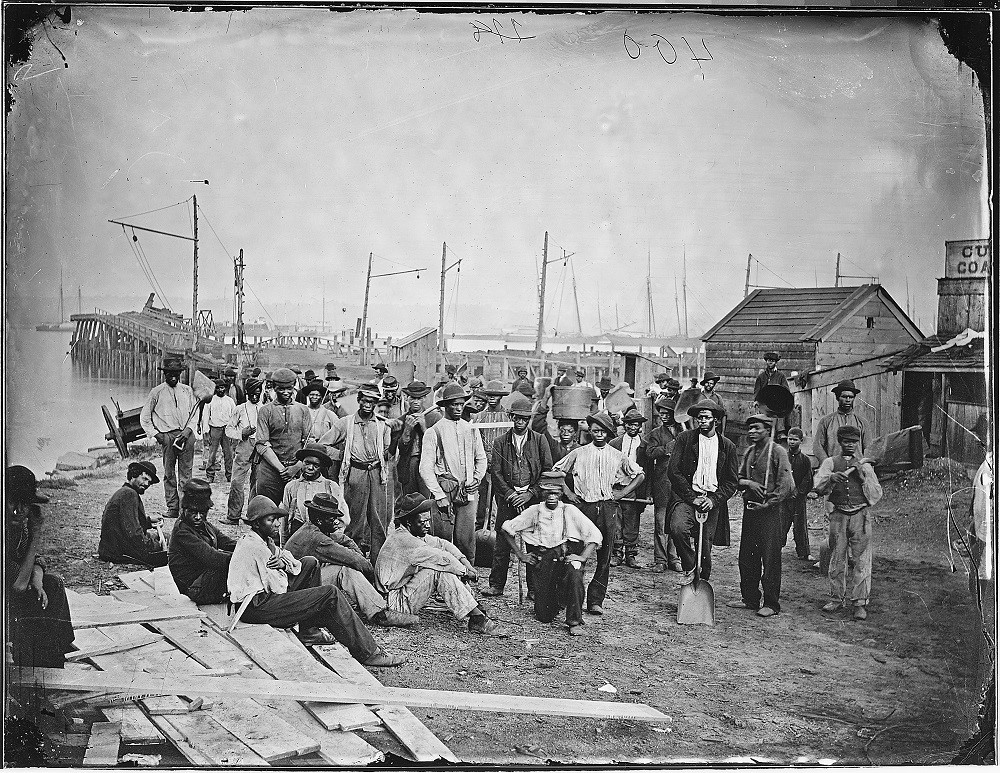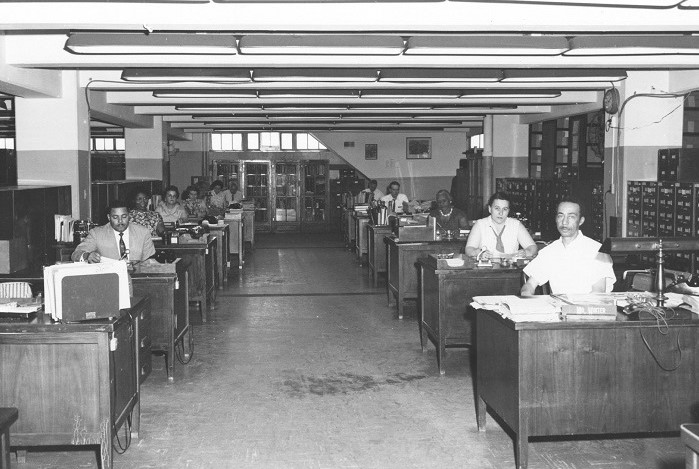African American workers at the Old Dominion Glass Corporation’s factory in 1911. The factory was located near the waterfront on the north side of Montgomery Street between Lee and Fairfax Streets.
But by the 1820s, Alexandria had become home to the largest domestic slave trading firm, which profited from the sale and trafficking of enslaved African Americans from the Chesapeake to the Deep South, dividing families.
 Noted Civil War photographer Matthew Brady captures an image of African American laborers at the Coal Wharf in Alexandria, ca. 1860-1865. The site is near Tide Lock Park in North Old Town.
Noted Civil War photographer Matthew Brady captures an image of African American laborers at the Coal Wharf in Alexandria, ca. 1860-1865. The site is near Tide Lock Park in North Old Town.
The Civil War revolutionized social and economic relations and newly freed African Americans found job opportunities as a result of the waterfront’s industrialization. From the Civil War to Civil Rights, the Alexandria waterfront witnessed the journey of African Americans in Alexandria that is highlighted in the city’s new African American Heritage Trail.
“It’s important for the story to be told but also important to see us, too. That’s why these wayfinding signs are important.”
— McArthur Myers, African American Heritage Trail committee member
The trail’s North Waterfront Route is the first in a series of trails covering the waterfront. It encompasses 11 stops featuring wayfinding signs along the path. Beginning at the foot of King Street, the trail ends at the historic Cross Canal site at the intersection of Montgomery and North Fairfax streets.
“We have more wayfinding signs scheduled to be placed along the trail,” said African American Heritage Trail committee member McArthur Myers. “We have identified certain spots and the city has committed over $80,000 for trail signage throughout the city.”
Noted Civil War photographer Matthew Brady was among many who documented the labor of African Americans along the Alexandria waterfront.
During the Civil War, many African American men who had escaped from slavery or who were already free worked on the Alexandria waterfront loading and unloading ships, building structures, and shoveling coal. A photograph taken during the war shows African American men standing and sitting next to the canal and in front of the old coal wharf, then used by the Union Quartermaster Corps.
Another stop along the trail is the Torpedo Factory Art Center. Alexandria’s Torpedo Station, begun in 1918, served numerous purposes for the American military until the City of Alexandria bought the complex in 1969.
The station failed to open before the end of World War I but the federal government maintained the building through the interwar period. At the time, African American men and women had limited job opportunities in the federal government, but the desegregation of the defense industries in 1941 began the process of integrating the station’s workforce.
 Workers at the Torpedo Factory Reference Service Unit circa 1950s.
Workers at the Torpedo Factory Reference Service Unit circa 1950s.
One of the Alexandria Torpedo Station’s least recognized but significant uses was for the storage, processing and return of records captured during World War II, the largest archival project ever undertaken by the U.S. government. From 1947 to 1968 archival collections were housed in Alexandria where African Americans completed much of the day-to-day work in the federal government’s increasingly desegregated workforce.
Each of the sites along the trail has a story to tell and the committee envisions the African American Heritage Trail as comprising several interconnecting routes in the City of Alexandria. Together, the trails will illuminate the history of the African American community over a span of several centuries from the waterfront to the city’s West End.
The walking tour was created by the African American Heritage Trail Committee with the support of the Office of Historic Alexandria. The tour can be experienced in-home on your computer or on your smartphone as you walk the trail along the Potomac River. The walking trail lasts about 45 minutes at a leisurely pace.
“It’s important for the story to be told but also important to see us too,” Myers stressed. “That’s why these wayfinding signs are important.”
For more information on the history of Alexandria’s African American community, visit the Alexandria Black History Museum, the Alexandria Archaeology Museum, the Freedom House Museum, Alexandria African American Heritage Park, Contraband and Freedmen’s Cemetery Memorial, Fort Ward Museum and Historic Site and the Charles Houston Recreation Center.
